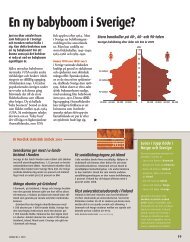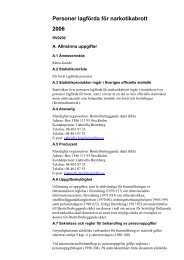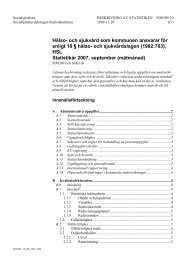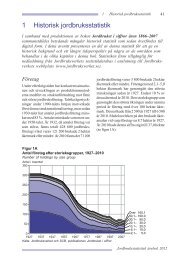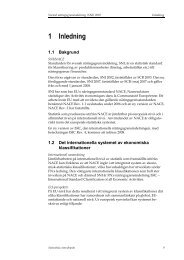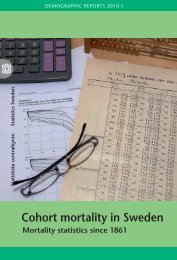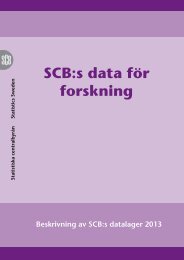Kvalitetsbegrepp och riktlinjer för kvalitets - Statistiska centralbyrån
Kvalitetsbegrepp och riktlinjer för kvalitets - Statistiska centralbyrån
Kvalitetsbegrepp och riktlinjer för kvalitets - Statistiska centralbyrån
You also want an ePaper? Increase the reach of your titles
YUMPU automatically turns print PDFs into web optimized ePapers that Google loves.
1.2 Comprehensiveness<br />
This quality component concerns how well the output from a "statistics system"<br />
describes a subject matter field in its "vital aspects". (For instance, how well the<br />
labour market statistics informs about vital aspects of the labour market.) However,<br />
no statistics system will live up to what all users regard as all the vital aspects of the<br />
subject matter field, but it can do so in a greater or less degree.<br />
2 ACCURACY of the statistics<br />
concerns agreement between statistics and target<br />
characteristics<br />
Usually there are so many disturbances in a statistical survey that the statistics do<br />
not give exact values of the target characteristics, only estimates. Here, the lead star<br />
is unbiased ("correct in average") estimates. Normally there is a discrepancy/deviation<br />
("error") between a statistic and its target value. The smaller the<br />
discrepancy is, the more accurate the statistic is. Of course users want discrepancies<br />
to be small, preferably negligible.<br />
Often, however, deviations are not negligible, and this is partcularly the case for<br />
statistics from sample surveys. Then, at least statistically knowledgeable users want<br />
numerical bounds for the deviations, referred to as accuracy measures or<br />
uncertainty measures. The derivation of such measures is a somewhat intricate<br />
matter, though, since the discrepancies depend on the target values, which are<br />
unknown. (If they were known, a survey would be superfluous.) Statements about<br />
accuracy of statistics inevitably fall in the category "statements concerning prevailing<br />
uncertainty", a conceptually intricate topic. The common way to present<br />
accuracy information is by uncertainty intervals, as indicated below.<br />
It is likely that the value of the target characteristic lies in :<br />
uncertainty interval = statistic ± margin of uncertainty.<br />
Often such an interval is a confidence interval with a specified confidence level. If<br />
this is 95 % , the interval encompasses the target value with a likelihood of 95 %.<br />
Other accuracy measures, in essence equivalent to a confidence interval,. are : standard<br />
deviation, coefficient of variation and relative margin of error. Sometimes<br />
uncertainty intervals are based on special evaluations of the survey, subject matter<br />
knowledge, experience, etc. Then one talks about judgement intervals.<br />
A classification of "errors" which is helpful in some contexts is as random or systematic.<br />
Random errors "fluctuate around 0", while systematic ones tend to "pull in<br />
the same direction" (have the same sign). Systematic errors may lead to biased statistics.<br />
2.1 Overall accuracy<br />
A user is chiefly interested in how well he/she can rely on the statistic from an<br />
overall point of view, i.e. to have a limit for the total deviation between the statistic<br />
and the target value. Sometimes, but as an exception rather than a rule, the producer<br />
can exhibit quantitative overall uncertainty intervals. Mostly, however, precise<br />
information can only be given concerning the extent and consequences of certain<br />
narrower sources of inaccuracy.<br />
A comment on accuracy<br />
Production of statistics can often be speeded up if standards of accuracy are lowered (by<br />
accepting large non - response, incomplete editing, etc.). Production time and accuracy<br />
are in conflict. In cases where fast statistics are judged to be important the dilemma is<br />
often handled by presenting "preliminary" statistics in a first round, and later "definite"<br />
statistics with better accuracy.<br />
37




